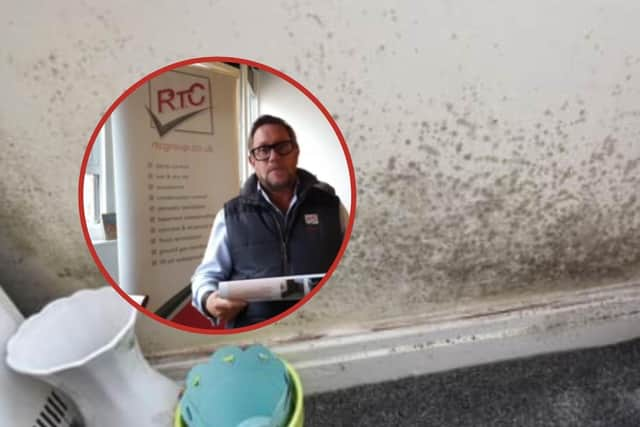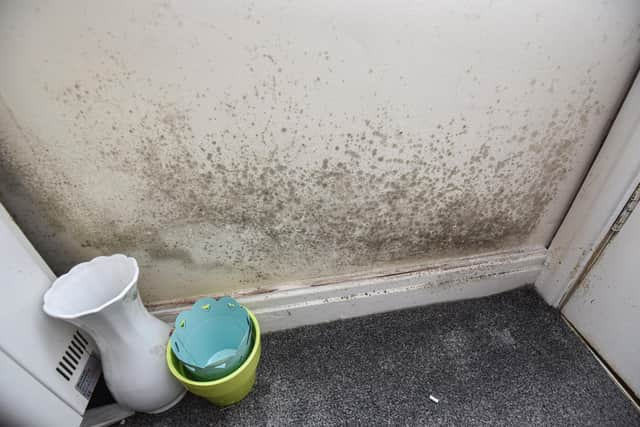Damp-proofing expert was in Blackpool for World Lung Day sharing his advice on how to reduce mould and damp in the home
and live on Freeview channel 276
Andrew Bradshaw, co-founder and partner at RTC, shared some simple hacks about how to cut the amount of moisture in the air – which is the main cause of mould growth.
During his speech, Mr Bradshaw advised people of easy solutions for damp homes – many don’t cost a penny!
Advertisement
Hide AdAdvertisement
Hide AdThe housing professional spoke to a crowd at HIVE Art Gallery on Church Street, as part of a project on lung health.


Citing the tragic death of two-year-old Awaab Ishak, he said it’s more important than ever to deal with condensation in the home, in order to prevent ill-health linked to mould.
The presentation was organised by the Aspergillosis Trust, as part of ‘The Air That I Breathe’ exhibition.
What causes damp?
Condensation arises when moist air comes into contact with cold surfaces such as windows and walls, where it will condense and release the moisture it holds onto that wall or other surface. Many things in the home will cause moisture in the air – including cooking, showering, breathing and drying clothes. Large dogs and houseplants will also produce moisture in the air.


Advertisement
Hide AdAdvertisement
Hide AdMr Bradshaw said: “Adequate heating and ventilation in domestic properties is the main prevention of problems associated with condensation and mould growth and, one without the other, will normally not be sufficient in preventing them from being an issue."
What are the health risks of damp and mould?
Babies and young children, the elderly and those with allergies and asthma are likely to suffer averse reactions to mould.
For those with allergies, breathing in or touching mould spores can cause severe reactions, including asthma attacks, fever and shortness of breath, while for others, mould can bring on a runny nose, red or itchy eyes and irritated skin.


Aspergillosis is a hidden lung disease, triggered by mould, that can be fatal.
Advertisement
Hide AdAdvertisement
Hide AdFor people who have weakened immune systems, breathing in spores can cause an infection in the lungs or sinuses which can spread to other parts of the body.
This chronic condition causes tenacious mucus production, breathlessness, wheezing and extreme fatigue.
Karen Birchall, 46, has asthma and said the green and black mould in her bedroom became so bad that she had to stop sleeping in there and move into her lounge, which is now starting to be affected by damp as well.
She said: "I have asthma, so I was worried about how it would affect that. After a while I had to move out of that room and sleep in the lounge but now that is started to be affected too.”
How can mould and damp affect my property?
Advertisement
Hide AdAdvertisement
Hide AdIt will initially affect walls, ceilings, bedding, clothes, furniture and carpets, as well as producing musty smells and damp conditions.
But, over time, it can lead to more serious problems.
Andrew Bradshaw added: “Properties will suffer, start to deteriorate and cause the owners and tenants even more financial implications.
“Furthermore, the risk to health that damp conditions can cause should not be ignored, especially with the very young, old and vulnerable.”
How can I reduce mould and damp in my home?
Andrew is recognised as one of the North West’s foremost authorities in damp problems and was involved with an innovative flood resilience project in Cumbria, which won the Environment Agency’s project excellence award for climate resilience.
Advertisement
Hide AdAdvertisement
Hide AdHe has shared his top tips to help keep damp and mould at bay.
Try keeping your heating on longer at a lower temperature. This will help to maintain a higher ambient temperature in the fabric of the building (and it’s more cost effective).
Keep the door to the bathroom closed. Moisture from bathrooms and kitchens can cause mould to form in other rooms and areas of the property, such as behind the bed.
Use an extractor fan in the kitchen and bathroom and don’t switch them off at the isolation switch.
Advertisement
Hide AdAdvertisement
Hide AdAvoid drying clothes on the radiator. If you must dry them inside, do it in the bathroom with the door shut and windows open.
Move items away from external walls. Furniture stored against the wall will trap the cold air, making it a breeding ground for mould spores.
Always put lids on pans while you are cooking. When boiling vegetables, don’t use more water than you need.
Never clean mould away with bleach, as this can make it come back even worse. Instead, you should use warm soapy water, or a dedicated mould removal cleaner.